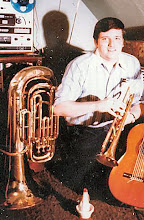

Side 1:
1. Washington And Lee Swing
2. I'm Goin' Home
3. Jazz Me Blues
4. Night and Day
5. South Rampart Street Parade
6. Sugar (That Sugar Baby O' Mine)
Side 2:
1. Tin Roof Blues
2. Royal Garden Blues
3. Panama
4. Blue (And Broken-Hearted)
5. The Original Dixieland One Step
6. Wolverine Blues
Liner Notes:
Al Hirt's Jazz Band Ball: Swinging Dixie from Dan's Pier 600 - New Orleans
Personnel:
Al Hirt trumpet
Bob Havens trombone
Roy Zimmerman piano
Pete Fountain clarinet
Bob Coquille bass
Paul Edwards drums
Photos by de Sylva-Dyer
Cover Artist, David Stone Martin
Art Director, Sheldon Marks
This LP was reissued in 1961 on Verve MGV 1028 by Al Hirt entitled "Blockbustin' Dixie!, then release 1965 on Metro (MGM) Records MS-517 Stereo / M-517 Mono again by Al Hirt entitled "Al Hirt"
If you're "up to here; satiated, weary of the dreary, same old tired phrases and "traditional solos" so prevalent in much of the Dixieland music one is accustomed to hearing - then this album is for you. Dan's Pier 600 is the furthermost club featuring dixieland music that one reaches when strolling from Canal Street along Bourbon Street, deep into the French Quarter of New Orleans. And as in the case of the builder of the better mouse-trap, whose wares were to he found deep in the woods, an ever-increasing host of fans of AI Hirt and his Band are beating a path to the door of Pier 600 - at 600 Bourbon Street.
First of all, this band swings - and swings hard, when the tempo and mood call for it; but at the same time there is a refreshing change in dynamics from time to time that reflects imagination and well- rehearsed head arrangements for ensemble passages that set it apart as not just another Dixieland band. Their "blues" renditions seem to tell a new story, too, as they should, of course - no two people having exactly the same backgrounds, loves, trials and tribulations; and what are the blues but a musical expression of one's thoughts on those subjects? Listen to Pete Fountain's infinitely beautiful solo on "Tin Roof Blues"; the next night it would be a little different, for one is a day older, new thoughts have shaded the
feelings to be expressed.
Al Hirt, leader and trumpet, has been well dubbed "The Gabriel of the South:' His technique and stamina are showcased on "Night and Day;" and the big man's sense of humor crops up frequently in half-valve emissions, trumpet and drum "chases" (as in "South Rampart Street Parade") and in some of the startling key changes, ensemble-wise, which are the result of his arranging.
Trombonist Bob Havens hails from Quincy, Illinois - and left Ralph Flanagan's dance band in the spring of 1956 when the urge to play Dixieland became too strong to resist. His fine, big tone is in evidence throughout the album; but it is given the lion's share of the solo work on "Blue (and broken-hearted):' The only other member of the band who is not a native New Orleanian is drummer Paul Edwards, who comes from Ohio. Bob and Paul both played in the band of the late George Girard until the latter's ill-health forced him to disband. Edwards' rock-steady beat and uncanny intuition regarding the whims of the other members of the aggregation help to make him a valuable member of the rhythm section. The same goes for bassist Bob Coquille who listens, augments, and provides good tone with his beat... (usually in 4/4, by the way - another refreshing innovation in contrast with some dixieland bands.) Coquille was also a member of the Girard band before joining Al Hirt.
Roy Zimmerman at the piano gives evidence of his healthy respect for such jazz greats as Jess Stacy and the late Bob Zurke. His St. Bernard like appearance and complete relaxation off the stand be-lie his concentration when at the piano driving, backing, plugging any holes that need filling.
One last word about Pete Fountain, whose tone on tenor sax on "Washington & Lee Swing" shows a becoming influence by a former New Orleanian, Eddie Miller. It was a stroke of luck that the wonderful rapport existing between these six men was finally recorded for the first time (other than on. their weekly broadcasts taped for CBS Radio and New Orleans affiliate WWL) - for less than a week after these sides were cut Pete left the group to accept a key chair with Lawrence Welk, who planned to build a Dixieland contingent around Pete as a special feature with his regular orchestra. Well, Irving Fazola eventually found the lure of his native New Orleans too strong to resist - and perhaps, like "Faz", Pete will return in time to "Pier 600", where tycoons, conventioneers, airline personnel, show-people and (the highest compliment) musicians from all types of bands, return again and again to hear a real "Jazz Band BALL!"
DICK MARTIN


No comments:
Post a Comment